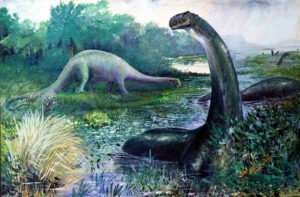Dinosaurs have holes called “quadratojugal” and “quadratojugal foramina” that are found in the skull. These holes have been so far only found in birds; no other reptiles or mammals have them!
Scientists also discovered that at least some dinosaurs had a jaw joint that allowed the lower jaw to move up and down while the rest of it remained still, just like most birds do today.
Further proof lies in their hip structure. In addition, the ostrich has features in its legs that indicate very similar structures to those of dinosaurs (see image).
In fact, experts believe birds inherited these characteristics from their dinosaur ancestors because they both have two-toed feet. To answer why there were such close similarities between many species of bird and dinosaur is difficult, but scientists have come up with several theories.
Paleontologists believe that birds and dinosaurs shared a common ancestor, who lived during the late Triassic period, approximately 200 million years ago. During this time, there was probably a huge explosion in the Earth’s population of species. It’s possible that many of these species did not survive, possibly due to poor weather conditions or food shortages.
Birds are attributed as surviving by feeding on small insects found in rotting vegetation on the ground (just like modern-day predatory birds) because they could reach them before other animals, such as mammals or reptiles, could get there.
The earliest known bird specimen so far discovered (referred to as “Protoavis” when identified in 1996) had teeth and clawed fingers and may have been able to walk rather than fly.
Still, the first creatures (or ancestors of birds) that were small enough to develop flight would have had a massive advantage over their rivals; they could fly away from danger instead of running away. It is possible that these early flying dinosaurs competed with feathered gliders and creatures similar to pterodactyls, as seen in modern-day Southeast Asia.
Over millions of years (perhaps even when the continents shifted), some species evolved into types better suited for sustained flight – ending up with today’s birds. Other species remained on the ground or took to trees and became part of modern animal life. Scientists theorize that following the breakup of Pangea, many birds spread quickly, reaching every continent in the blink of an eye, different species developing independently from one another due to distance and geographical barriers.
Paleontologists believe it took about 60 million years for the first actual bird (Archaeopteryx) to appear.





